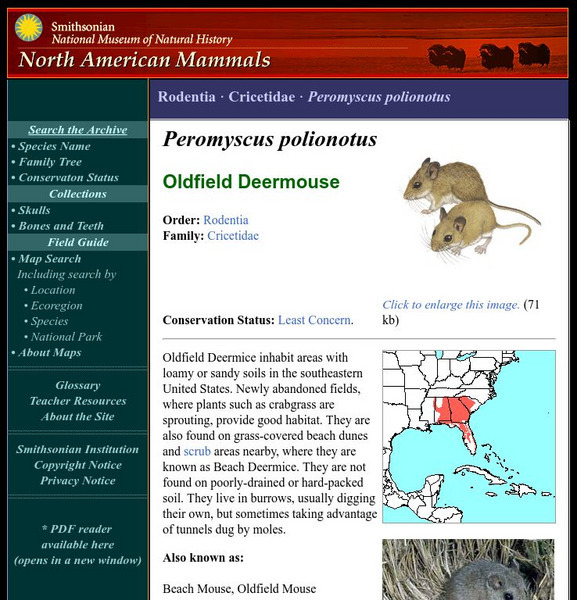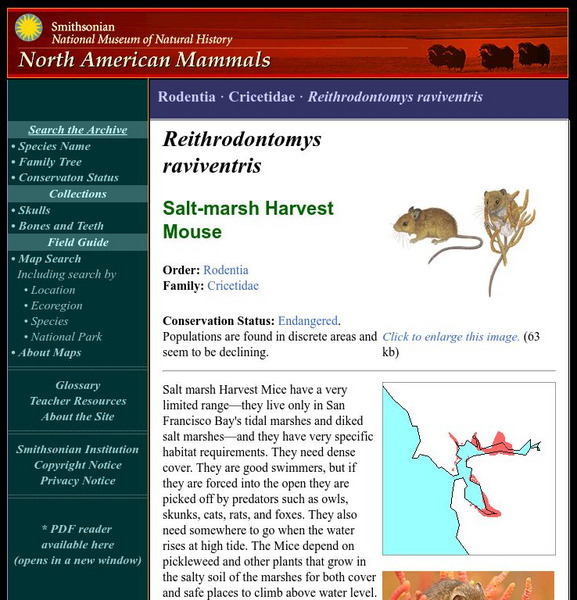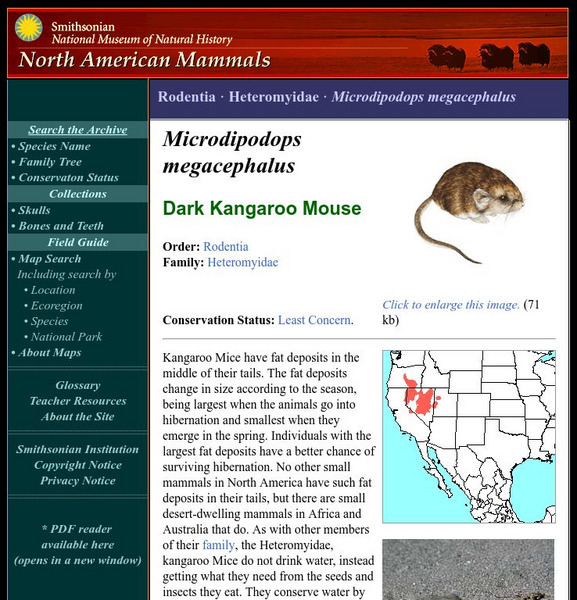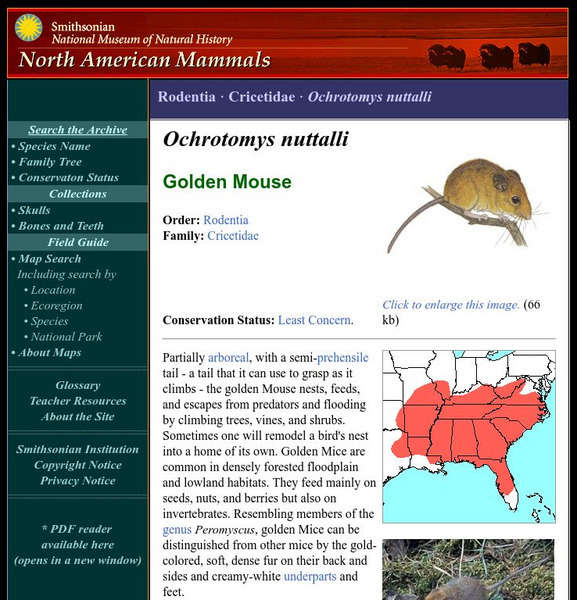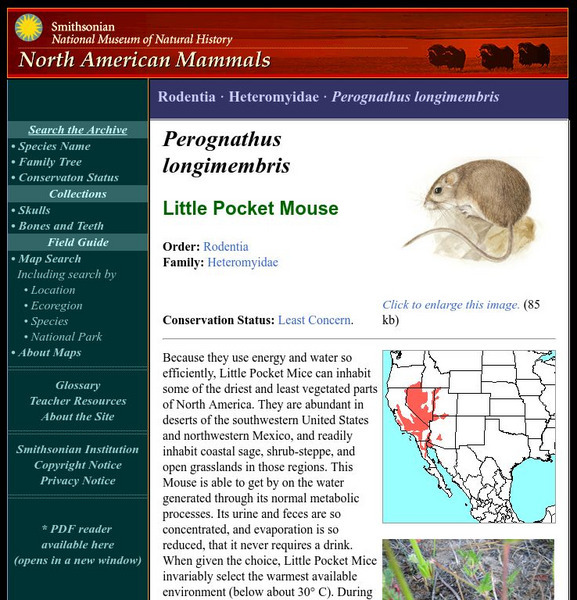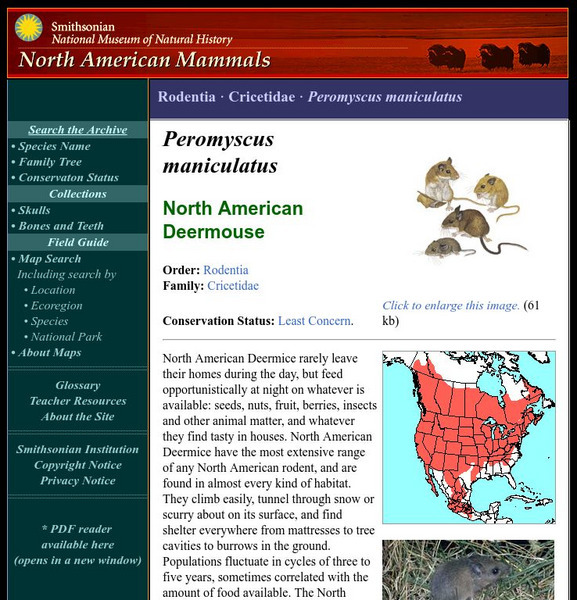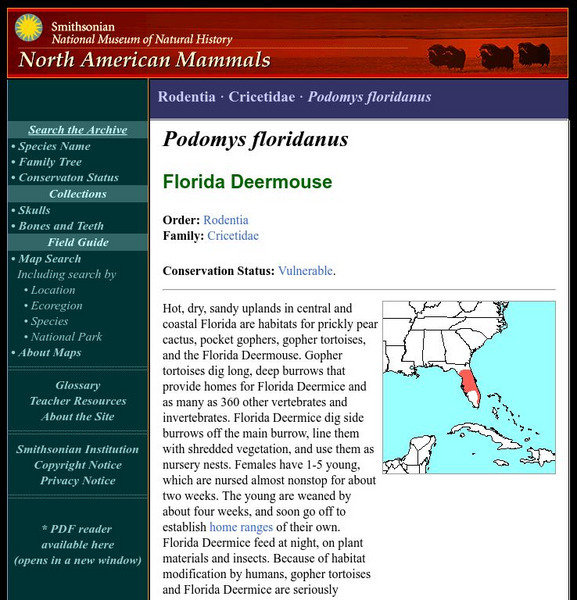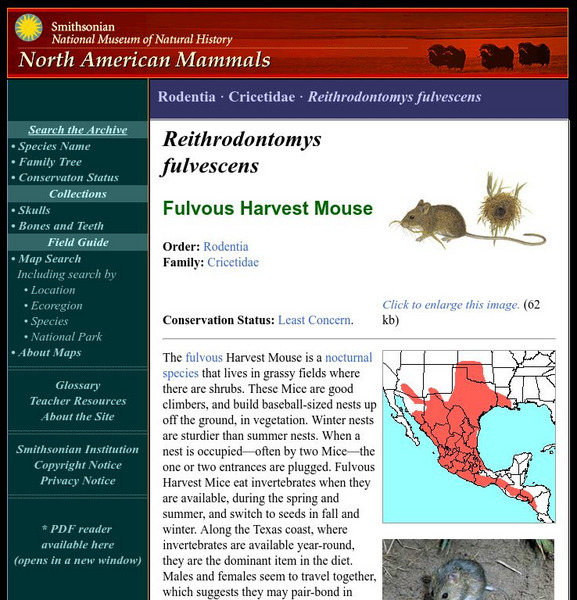Smithsonian Institution
National Museum of Natural History: American Mammals: Mesquite Mouse
Mesquite Mice live in dense mesquite thickets known as bosques. Although mesquite is the dominant plant in bosques, other desert plants such as palo-verde, prickly pear, and cholla cacti, and grasses, mix with the mesquite. Learn more...
Smithsonian Institution
National Museum of Natural History: American Mammals: White Footed Mouse
The White-footed Mouse has a very wide distribution. It is the most abundant rodent in mixed deciduous and coniferous forests in the eastern United States, and is probably equally abundant near farms. Learn more about the Peromyscus...
Smithsonian Institution
National Museum of Natural History: American Mammals: Northwestern Deermouse
Keen's Deermouse is the most common deermouse in the Pacific Northwest. It inhabits rainy, mild climate zones at higher elevations than the closely-related Deermouse (Peromyscus maniculatus), and prefers areas where the forest canopy is...
Smithsonian Institution
National Museum of Natural History: American Mammals: Osgood's Mouse
Osgood's Mouse is a very close relative of the Pinyon Mouse but is larger, and its tail is longer than the head and body. Osgood's Mouse lives in the mountains of southern New Mexico and throughout mountainous central Mexico. Learn more...
Smithsonian Institution
National Museum of Natural History: American Mammals: Pinyon Deermouse
Pinyon Deermice reproduce from mid-February through mid-November, giving birth to litters of 3-6 blind, hairless young that weigh about 2.3 g each. Learn more about the Peromyscus truei, more commonly known as a Pinyon Mouse, in this...
Smithsonian Institution
National Museum of Natural History: American Mammals: Oldfield Mouse
Oldfield Mice inhabit areas with loamy or sandy soils in the southeastern United States. Newly abandoned fields, where plants such as crabgrass are sprouting, provide good habitat. Learn more about the Peromyscus polionotus, more...
Smithsonian Institution
National Museum of Natural History: American Mammals: Plains Harvest Mouse
Plains Harvest Mice are found in grassy areas, including hay and wheat fields. They seem to prefer shorter grasses, and build round nests of grass on or near the ground. Learn more about the Reithrodontomys montanus, more commonly known...
Smithsonian Institution
National Museum of Natural History: American Mammals: Salt Marsh Harvest Mouse
Salt-marsh Harvest Mice have a very limited range, they live only in San Francisco Bay's tidal marshes and diked salt marshes and they have very specific habitat requirements. They need dense cover. Learn more about the Reithrodontomys...
Smithsonian Institution
National Museum of Natural History: American Mammals: Western Harvest Mouse
Western Harvest Mice are adaptable, widespread, and abundant, especially in meadows, prairies, old pastures, stream valleys, and marshes. They eat seeds, insects, and plants. Learn more about the Reithrodontomys megalotis, more commonly...
Smithsonian Institution
National Museum of Natural History: American Mammals: Spiny Pocket Mouse
The Spiny Pocket Mouse is somewhat shaggy. Its spines, which are mostly on the rump, are not nearly as stiff as porcupine quills. Learn more about the Chaetodipus spinatus, more commonly known as a Spiny Pocket Mouse, in this...
Smithsonian Institution
National Museum of Natural History: American Mammals: Nelson's Pocket Mouse
Nelson's Pocket Mice live in the Chihuahuan Desert of north-central Mexico and adjacent parts of western Texas and southern New Mexico. They are found mostly in rocky areas where there are some shrubs to provide cover. Learn more about...
Smithsonian Institution
National Museum of Natural History: American Mammals: Rock Pocket Mouse
As their name indicates, Rock Pocket Mice dwell in rocky habitats, and only rarely live in areas with sandy or silty soils. Their inconspicuous burrows are located near or under rocks, in rocky gulches or canyons, or near boulders. Learn...
Smithsonian Institution
National Museum of Natural History: American Mammals: Long Tailed Pocket Mouse
The range of the Long-tailed Pocket Mouse is mostly within the Mojave Desert, Colorado Desert, and the Great Basin. On cold nights, this animal becomes inactive and usually remains within its burrow system during winter. Learn more about...
Smithsonian Institution
National Museum of Natural History: American Mammals: San Diego Pocket Mouse
The San Diego Pocket Mouse occurs in desert and coastal habitats in southern California, Mexico, and northern Baja California, from sea level to at least 1,400 m. Yellowish or orange hair on its sides contrasts with a dark brown back,...
Smithsonian Institution
National Museum of Natural History: American Mammals: Meadow Jumping Mouse
Meadow Jumping Mice have very long tails and very large feet. They are most common in grassy or weedy fields, where they use runways made by other rodents. Learn more about the Zapus hudsonius, more commonly known as a Meadow Jumping...
Smithsonian Institution
National Museum of Natural History: American Mammals: Western Jumping Mouse
Western Jumping Mice are common in meadows, streamsides, and marshes in northwestern mountains. They also occur in subalpine meadows, and are found at low densities in dry, low-elevation, grassy habitats. Learn more about the Zapus...
Smithsonian Institution
National Museum of Natural History: American Mammals: Pacific Jumping Mouse
Pacific Jumping Mice are remarkably quick and unpredictable. They push off with both hind feet and land on both forefeet, apparently using the tail for balance--a Mouse who had lost its tail somersaulted trying to land. Learn more about...
Smithsonian Institution
National Museum of Natural History: American Mammals: Dark Kangaroo Mouse
Kangaroo Mice have fat deposits in the middle of their tails. The fat deposits change in size according to the season, being largest when the animals go into hibernation and smallest when they emerge in the spring. Learn more about the...
Smithsonian Institution
National Museum of Natural History: American Mammals: Golden Mouse
Partially arboreal, with a semi-prehensile tail - a tail that it can use to grasp as it climbs - the golden Mouse nests, feeds, and escapes from predators and flooding by climbing trees, vines, and shrubs. Sometimes one will remodel a...
Smithsonian Institution
National Museum of Natural History: American Mammals: Great Basin Pocket Mouse
The Great Basin Pocket Mouse is the largest member of the genus. It inhabits arid and semi-arid habitats in nearly the entire Great Basin region of western North America, particularly where sagebrush dominates the vegetation. Learn more...
Smithsonian Institution
National Museum of Natural History: American Mammals: Little Pocket Mouse
Because they use energy and water so efficiently, Little Pocket Mice can inhabit some of the driest and least vegetated parts of North America. They are abundant in deserts of the southwestern United States and northwestern Mexico, and...
Smithsonian Institution
National Museum of Natural History: American Mammals: North American Deermouse
North American Deermice rarely leave their homes during the day, but feed opportunistically at night on whatever is available: seeds, nuts, fruit, berries, insects and other animal matter, and whatever they find tasty in houses. Deermice...
Smithsonian Institution
National Museum of Natural History: American Mammals: Florida Mouse
Hot, dry, sandy uplands in central and coastal Florida are habitats for prickly pear cactus, pocket gophers, gopher tortoises, and the Florida Mouse. Gopher tortoises dig long, deep burrows that provide homes for Florida Mice and as many...
Smithsonian Institution
National Museum of Natural History: American Mammals: Fulvous Harvest Mouse
The fulvous Harvest Mouse is a nocturnal species that lives in grassy fields where there are shrubs. These Mice are good climbers, and build baseball-sized nests up off the ground, in vegetation. Learn more about the Reithrodontomys...







